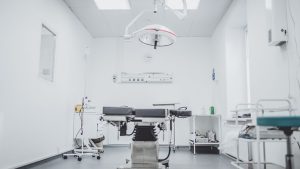
Who are the most crucial staff inside a medical facility?
Ask any hospital patient or visitor, and they will usually give one of three answers:
- Doctors
- Surgeons
- Nurses
None of these answers are wrong. However, you almost never hear someone mention the Environmental Services (EVS) Staff.
These staff members are responsible for properly cleaning and disinfecting all areas throughout a healthcare facility – seven days a week, 365 days a year.
Holding the line
People often refer to the EVS team as the “the front line of infection control” because they play one of the most critical roles in the medical industry today: cleaning.
Without effective and consistent cleaning, a hospital becomes an increasingly dangerous place for patients. A medical facility’s cleanliness can be directly correlated to the knowledge and efficiency of its EVS team. The cleanliness of a medical facility also directly affects the prevalence of hospital-acquired infections and illnesses within that facility.
EVS staff are generally very good at handling the terminal cleaning associated with post-operation disinfection and patient discharge, for example. However, not all EVS staff are fully prepared for the cleaning required during and after construction and/or demolition projects.
The unique challenges of construction in a healthcare environment

Every medical facility will inevitably require renovation and construction at some point.
Unfortunately, environmental disturbances associated with construction activities in healthcare facilities pose unique airborne and waterborne threats for patients at risk of healthcare-associated opportunistic infections.
Although upgrading older facilities is a good thing, renovation and construction creates immense amounts dust and debris, which can be extremely dangerous to patients with weakened immune systems.
On any given day, about one in 31 hospital patients has at least one healthcare-associated infection, according to the CDC National Healthcare Safety Network (NHSN).
Consider mold, for example.
The common Aspergillus fungus can be fatal to immune-compromised patients. A previous scientific review revealed that construction or renovation activities within the hospital or in surrounding areas accounted for approximately half the sources of healthcare-associated aspergillosis outbreaks. These outbreaks occur because construction/renovation activities frequently disperse large amounts of airborne dust contamination along with fungal spores. The CDC’s Hospital Infection Control Practice Guidelines (HICPAC) recommend the following steps to take during construction.
- Ensure that properly trained infection-control personnel are actively involved during all phases of demolition, construction, and/or renovation within the healthcare facility.
- Perform a risk assessment of the necessary types of construction barriers and install them properly.
- Make daily assessments and document the presence of negative airflow within the construction zone or renovation area.
- Upon completion of the project, the contractor should clean the work zone according to facility procedures, and install barrier curtains with HEPA filtered recirculation to contain dust and debris before removing any rigid construction barriers. Then the hospital should perform terminal cleaning before removing these barrier curtains.
Risk assessment, oversight, and post-construction terminal cleaning are all critical steps in preventing hospital acquired infections like aspergillosis.
Beware what you can’t see

The human eye cannot detect aspergillus spores in construction debris, in the air, or on surfaces. Therefore, you must provide training to EVS personnel on the complexities of dust migration and dust adhesion to walls and ceilings. Additionally, the CDC describes various methods for dust mitigation in healthcare facilities and has provided beneficial risk-management strategies, such as the use of airborne particle sampling to monitor the effectiveness of air filtration systems and dust-control measures. Quantitative polymerase chain reaction (QPCR) bioaerosol air sampling is another strategy for the more sensitive areas within a facility, such as ICU, BMT, and oncology.
If your EVS staff requires additional training or oversight during an upcoming construction project, Higgins and Associates, LLC is available to provide comprehensive and specialized consulting in environmental infection control during construction.
Call (303) 708-9846 or visit our website to learn about relevant healthcare EHS services.
Related Articles:
- How Solid is Your Healthcare ICRA Construction Program?
- COVID-19 Pandemic and HVAC Filter Replacement Safety Precautions
References:
- https://www.cdc.gov/hicpac/pubs.html
- https://www.cdc.gov/infectioncontrol/guidelines/environmental/background/services.html
- https://www.cdc.gov/MMwr/preview/mmwrhtml/rr5210a1.htm
- https://www.cdc.gov/infectioncontrol/pdf/guidelines/environmental-guidelines-P.pdf
- https://www.ncbi.nlm.nih.gov/pmc/articles/PMC7313520/pdf/main.pdf
- https://www.cdc.gov/hai/data/index.html#:~:text=Although%20significant%20progress%20has%20been,least%20one%20healthcare%2Dassociated%20infection
- https://academic.oup.com/cid/article/61/3/433/490927



